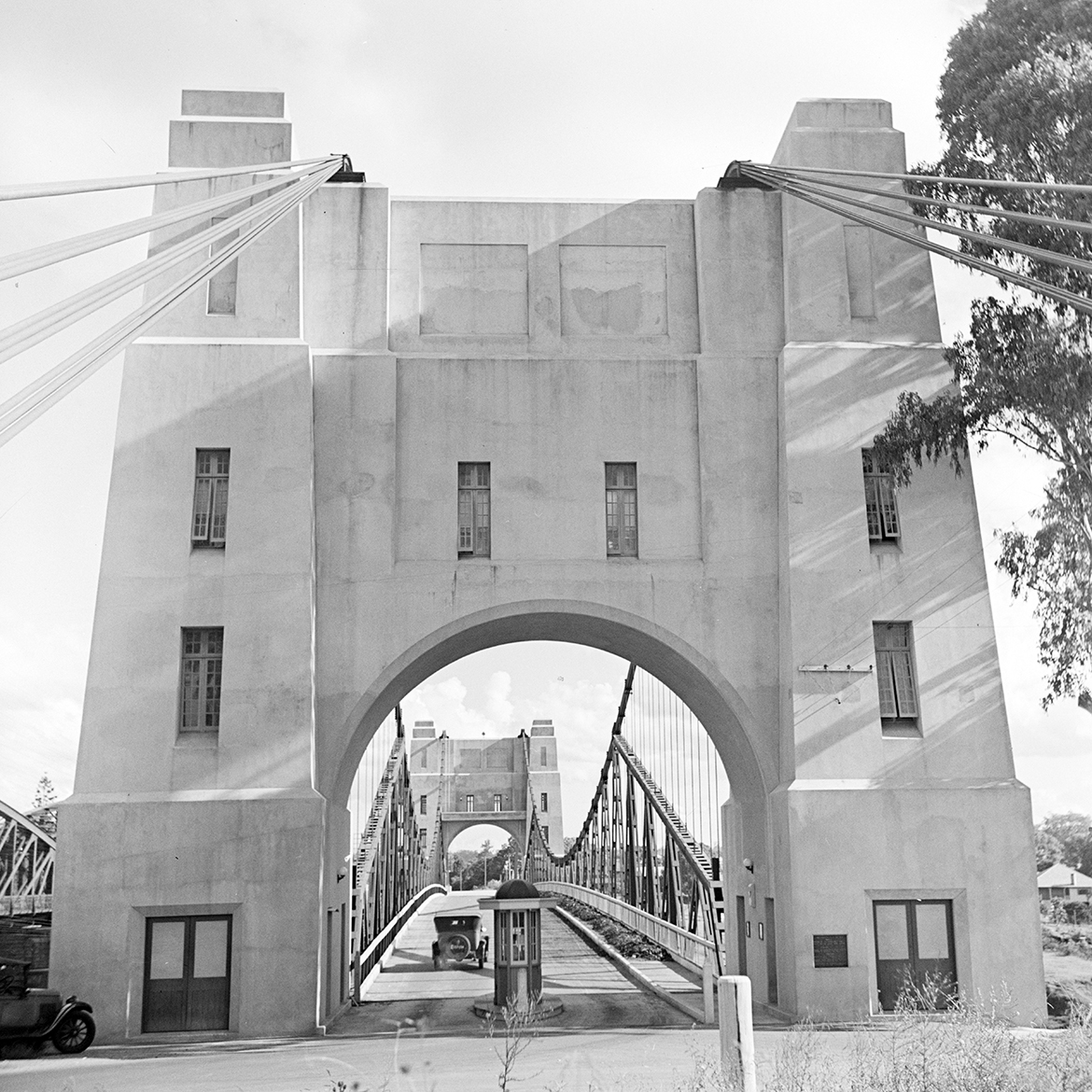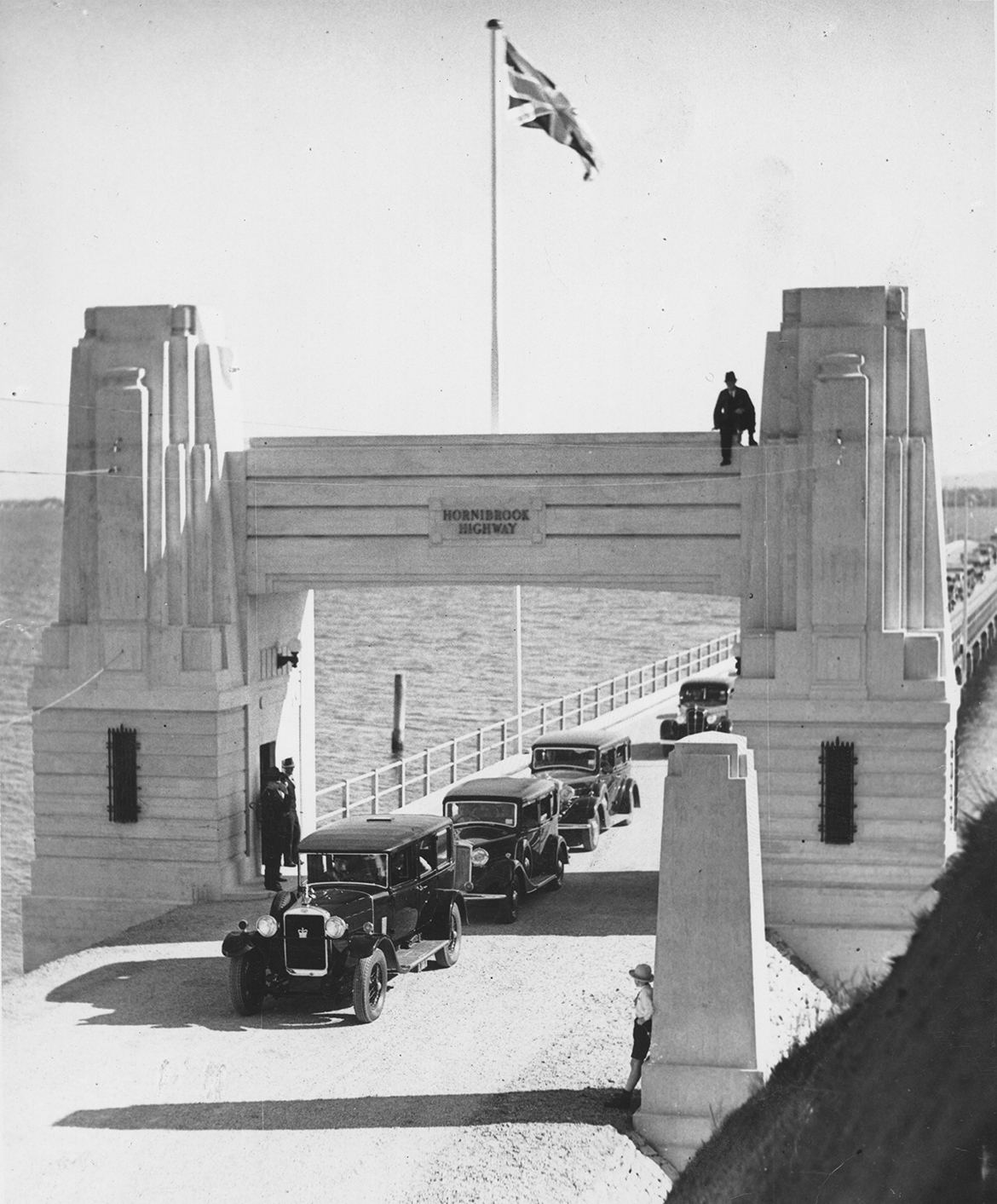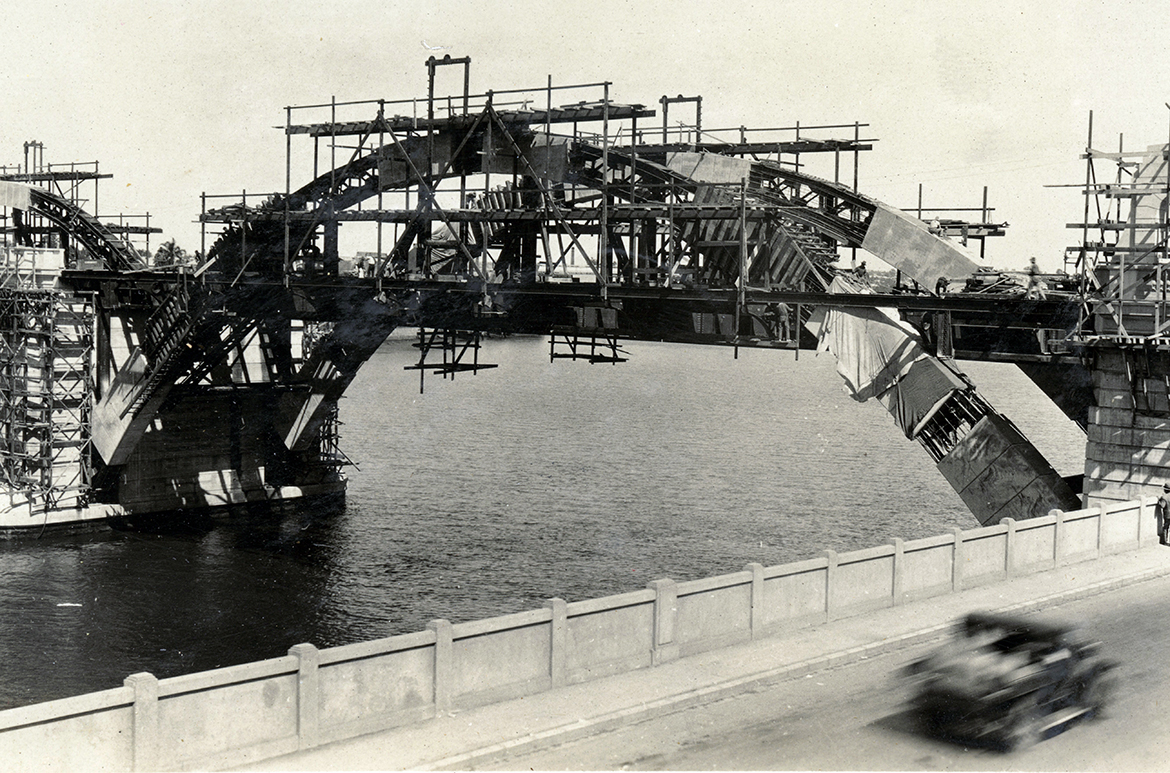Go back in time before Brisbane’s Grey Street Bridge

Brisbane is known as the ‘River City’ and a great way to get around is to jump aboard one of the river cruises or CityCat and ferry services on offer, if you are travelling by land, you can rely on the many vehicle, cycle and pedestrian bridges, although that was not always the case.
Both the Queensland Art Gallery and Gallery of Modern Art (QAGOMA) are surrounded by bridges, however South Brisbane and the South Bank site that QAGOMA now occupies once depended on one river crossing to access the city central business district on the north bank. The original Victoria Bridge (illustrated) which opened in 1874 was the first road crossing over the river and an important transport and communications link between the two banks — its replacement entered service in 1897 (illustrated) while the current streamlined modernist bridge which opened in 1969 is the third permanent crossing at this location and is now at the Queensland Art Gallery’s doorstep.
RELATED: Queensland Art Gallery: The beginning of South Bank’s transformation
First Victoria Bridge 1874

View of South Brisbane featuring the second Victoria Bridge 1905

View of the future Grey Street Bridge crossing at Kurilpa Point 1905

The need for further cross river links became evident as Brisbane grew and a new bridge linking the south bank peninsula at Kurilpa Point to North Quay to divert traffic away from the Victoria Bridge and the center of Brisbane was required, this was to be the Grey Street Bridge, which the Gallery of Modern Art now accompanies.
Grey Street Bridge 1932

View of Grey Street Bridge from the Gallery of Modern Art

Brisbane was a growing city in a construction boom at the time the Grey Street Bridge (1928-32) was commenced. The intense building activity during the 1920s and 30s saw the construction of major capital works programs, bridges and buildings such as the Brisbane City Hall (1920-30), Shrine of Remembrance and Anzac Square (1928-30), Indooroopilly Toll Bridge (1930-36) (illustrated), Hornibrook Highway Bridge (1932–1935) (illustrated), and the Story Bridge (1935-40) (illustrated) to name just a few.
Indooroopilly Toll Bridge 1936

Hornibrook Highway Bridge 1935

Geoffrey Powell ‘Construction of the Story Bridge’ 1939

Symbols of an emerging modern city fostered considerable enthusiasm in Queensland contemporary artists and inspired numerous images of industry and a dynamic city during a time of ambitious nation-building projects across Australia and later to offset the effects of the Great Depression.
Here we delve into the depictions of the Grey Street Bridge and celebrate the construction of Brisbane’s oldest road crossing, now nearing 100 years. It’s not often you can view the subject of an work in a gallery setting and have that inspiration just outside to observe in real life.
Grey Street Bridge
The Grey Street Bridge was one of the first major capital works of the newly formed Brisbane City Council in 1925 which amalgamated the City of Brisbane and the City of South Brisbane and numerous neighboring towns and shires. The bridge design with three graceful arches was constructed during the Art Deco period when overseas influences were brought back to southeast Queensland.
Two other bridges, the Indooroopilly Bridge in Brisbane’s west, and the Hornibrook Bridge on Moreton Bay had Art Deco styling in their concrete arched towers framing the entry and exit approaches. This short-lived movement was a transitional period between traditional and modern approaches to building, combining traditional elements with modern design.
An unusual feature of the Grey Street Bridge is that the curving, modern arches rise through the deck, sharing this feature with the Sydney Harbour Bridge (illustrated), however the Brisbane bridge has its steel frame arches covered with a concrete veneer.
Harold Cazneaux ‘Bridge, West Circular Quay’ (Sydney Harbour Bridge) 1931

Grey Street Bridge during construction 1929



The Grey Street Bridge was designed by (Alison Eavis) Harding Frew (1883-1952) a Queensland civil engineer. Frew recommended the design to be of concrete-encased steel with arched ribs which rise through the deck, a graceful and innovative design. In the Brisbane Courier Mail on 1 March 1927 Frew appeals for beauty:
Surely… the time has now arrived when some improvement in the appearance of at least our city bridges should be looked for in Queensland, and it is undoubtedly to European practice that engineers should turn to obtain more aesthetic results.
The question of utility and aesthetics should be weighed carefully, especially in relation to a city’s importance, its civic pride, and its future.
Beautiful bridges are an asset to any town; the beauty, however, must not be confused with ornamentation… the shape, proportions, and dimensions of the main structural parts must convey the idea of handsomeness, and ornamentation must be considered and treated as subservient to structural members and so should be only applied to enhance structural lines, without indulging in purposeless scroll work or expensive statuary.
The Grey Street Bridge was officially opened on 30 March 1932, eleven days after the opening of the Sydney Harbour Bridge (19 March 1932). It would be another eight years before the Story Bridge (6 July 1940) would connect Kangaroo Point and the southern and eastern suburbs adding another bridge access to the Brisbane central business district.
On 5 July 1955 the Grey Street Bridge was renamed the William Jolly Bridge in memory of William Jolly who was the first Lord Mayor of Brisbane.
Official opening celebrations, Grey Street Bridge 1932


‘The Queenslander’ bridge souvenir 1932

Grey Street Bridge lit at night

Rose Simmonds
A Bromoil transfer photograph of the Grey Street Bridge (illustrated) taken by Rose Simmonds (1877–1960) in 1933 — not long after the bridge was officially opened on 30 March 1932 — is currently on display in the Australian Art Collection at the Queensland Art Gallery.
Simmonds’ photography has an important position in the Queensland Pictorialist photography movement. Taking her lead from the atmospheric landscape painters such as JJ Hilder and Sydney Long, Simmonds explored techniques and processes which endowed the photograph with a more painterly quality, in favour of soft-focus and low-toned prints, producing romanticised images of her subject. Bromoils were favoured during the Pictorialist movement, elevating photography to an art form.
DELVE DEEPER: Rose Simmonds: A nostalgia for Queensland’s past
Rose Simmonds ‘Grey Street Bridge’ 1933

Vida Lahey
With the interest in the massive public works under construction in Brisbane at the time, the building of a central city bridge provided Vida Lahey (1882–1968) with watercolour studies of the bridge under construction with Building the bridge 1931 (illustrated) and The new bridge 1931 (illustrated).
DELVE DEEPER: The art & life of Vida Lahey
Vida Lahey ‘Building the bridge’ 1931

Vida Lahey ‘The new bridge’ 1931

Stanley W Eutrope
Stanley William Eutrope (1891–1983) was also inspired to document the Grey Street Bridge when completed with Under the bridge c.1933 (illustrated) and The bridge approach c.1935 (illustrated). An expert at the bromoil photographic process, Eutrope’s work was noted for its decorative and graphic effects. The process combines photography, painting and printmaking, where a photograph’s silver image is removed and substituted with ink.
DELVE DEEPER: Stanley William Eutrope: Elevating photography to an art form
Stanley W Eutrope ‘Under the bridge’ 1933

Stanley W Eutrope ‘The bridge approach’ 1935

Additional supplementary material sourced by Elliott Murray, Senior Digital Marketing Officer, based on QAGOMA curatorial research.
Featured image detail: Rose Simmonds (Grey Street Bridge, Brisbane) c.1933
#QAGOMA




